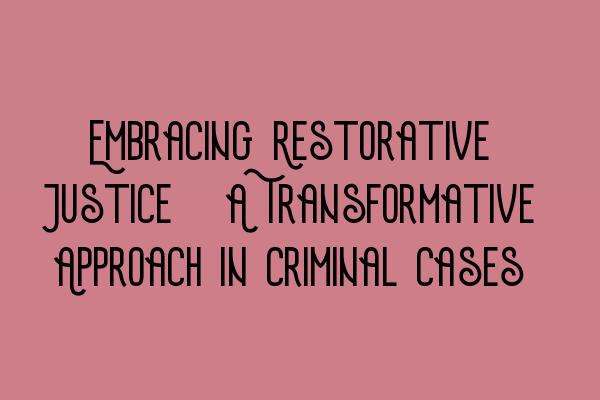Embracing Restorative Justice: A Transformative Approach in Criminal Cases
Restorative justice is a transformative approach that is gaining recognition in the criminal justice system. It offers an alternative to the traditional methods of punishment and aims to repair the harm caused by crime. In this blog post, we will explore the concept of restorative justice, its benefits, and how it can be effectively implemented in criminal cases.
What is Restorative Justice?
Restorative justice is a victim-centered approach that focuses on healing and reconciliation. It brings together the offender, the victim, and the community in a process that aims to address the harm caused by the crime and promote accountability.
Unlike the traditional punitive system, restorative justice seeks to empower victims and provide them with the opportunity to share their experiences, express their feelings, and have a say in the resolution process. It also encourages offenders to take responsibility for their actions, understand the impact of their behavior, and make amends.
The Benefits of Restorative Justice
Restorative justice offers a range of benefits for all parties involved. For victims, it provides a sense of closure and healing. It allows them to have their voices heard and actively participate in the resolution of the case. They can also receive emotional support and obtain compensation for any losses they may have experienced.
For offenders, restorative justice offers the opportunity for rehabilitation and personal growth. By directly addressing the harm caused, offenders can gain insight into the consequences of their actions and develop empathy and understanding. This can support their reintegration into society and reduce the likelihood of reoffending.
The community also benefits from restorative justice. It fosters a sense of safety, unity, and accountability within the community. It encourages community involvement in the criminal justice process and promotes trust and collaboration between individuals and community organizations.
Implementing Restorative Justice in Criminal Cases
Implementing restorative justice in criminal cases requires a collaborative effort from various stakeholders, including legal professionals, the police, victim support organizations, and community representatives. It involves a structured process that includes:
- Referral: Identifying suitable cases for restorative justice and obtaining consent from victims and offenders to participate.
- Preparation: Conducting individual meetings with the victim and offender to explain the process, set expectations, and address any concerns or questions.
- Mediation: Facilitating a dialogue between the victim and offender, guided by a trained mediator. This can be done through face-to-face meetings, conferences, or even virtual platforms.
- Resolution: Reaching an agreement that addresses the harm caused, such as apology, restitution, community service, or participation in rehabilitation programs.
This process is carried out in a supportive and controlled environment, ensuring the safety and well-being of all participants.
Conclusion
Restorative justice offers a transformative approach to criminal cases, allowing victims to have a voice, promoting offender accountability, and fostering community unity. By embracing restorative justice, the criminal justice system can work towards creating a more inclusive, rehabilitative, and just society.
